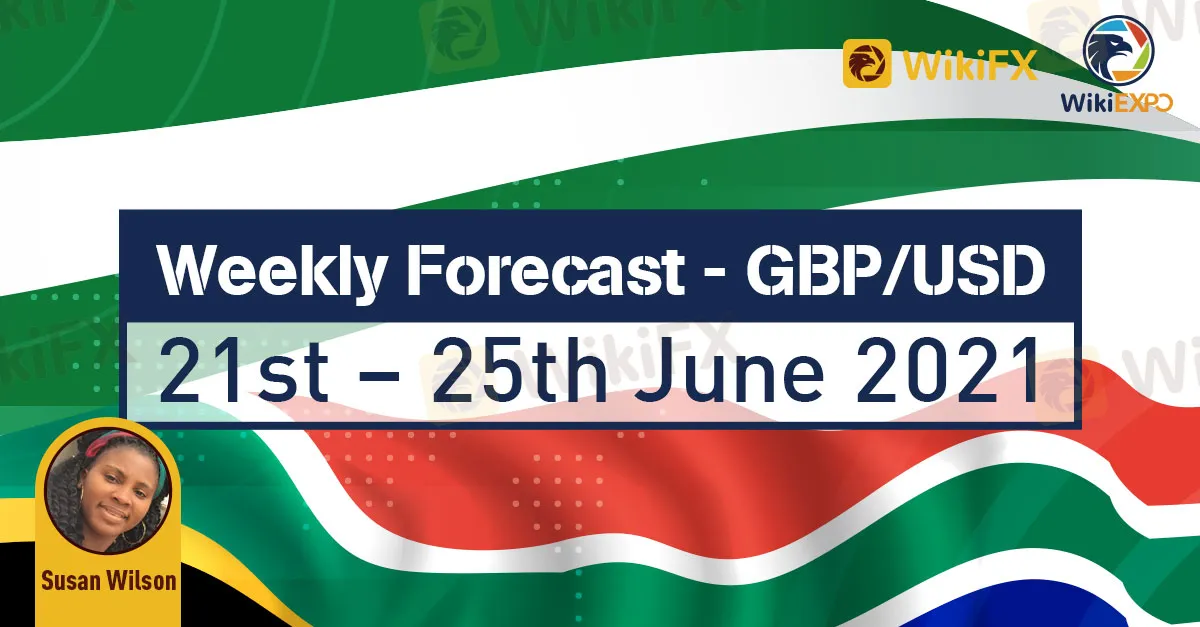简体中文
繁體中文
English
Pусский
日本語
ภาษาไทย
Tiếng Việt
Bahasa Indonesia
Español
हिन्दी
Filippiiniläinen
Français
Deutsch
Português
Türkçe
한국어
العربية
Weekly Forecast - GBP/USD 21st – 25th June 2021
Abstract:Hawkish Fed – these words have seldom been printed together when the sudden alteration from the earth’s most authoritative bank has been enhancing the buck. For GBP-USD, the decision now swings to the BoE, which needs to consider economic hopefulness and the widespread of the covid virus.

Daily chart for mid-June shows bears taking charge.

Hawkish Fed – these words have seldom been printed together when the sudden alteration from the earths most authoritative bank has been enhancing the buck. For GBP-USD, the decision now swings to the BoE, which needs to consider economic hopefulness and the widespread of the covid virus.
GBP-USD this week
The Fed surprised financial markets by indicating two rate climbs in 2023, conflicting to none at all previously. Also, the bank elevated other predictions such as that for inflation – with basic prices set to hit 3% in 2021 – and heralded the fast regaining.
The predictions of less dollars printed and increased borrowing costs pushed the dollar swelling across the charts, and the greenback hardly stilled to break in even when Treasury yields came down.
Stockholders would like to know if the bank is bearing in mind diminishing some of its stimuli anytime soon. The Bank of England declared a slight reduction to the stride of its bond buys last time, without changing the scope. Conversely, Chief Economist Andy Haldane recommended tapering is needed for the economy.
Besides the Bank of England, Markit's preliminary purchasing managers' indexes for June may likely push the cable, particularly that for the large services sector.
Technical Analysis – GBP-USD
Bears are gaining grounds. The pounds abrupt drop sent impetus on the daily chart to negative region for the first time since April. Besides, the duo sliced through the 50-day and the 100-day SMA. At the time of scripting this analysis, the Relative Strength Index (RSI) is still above 30, hence above oversold area, contributing to the bearish bias.
Some support area is at 1.3855, the post-Fed manger. It is shadowed by price 1.38, which mitigated GBP-USD at the beginning of last month, and by the crucial 1.3670 line that was a double bottom during the spring. Even lesser, 1.3565 is the next downside mark.
At price 1.3930 lies some resistance, which detained pound earlier last month, then by 1.4010, the sieve of trading ranges which had formerly crumpled regaining efforts. Further above is 1.4140 and 1.4220.

Sentimental Analysis – GBP-USD
The US Federal Reserve bullish surprise will probably have more swelling impacts on financial markets, holding the dollar bid. The Bank of England is improbable to completely imitate the Fed, and short of a strong zenith in the pandemic cases, heaviness on the pound is set to linger further. Above all, another week of dips is on the cards, with the Bank of England only offering restricted care.

Disclaimer:
The views in this article only represent the author's personal views, and do not constitute investment advice on this platform. This platform does not guarantee the accuracy, completeness and timeliness of the information in the article, and will not be liable for any loss caused by the use of or reliance on the information in the article.
Read more

Trading Psychology – 4 Wise Quotes From The Legendary Mark Douglas
In the world of trading, few books have had the impact of Mark Douglas’ big hit Trading in the Zone. Written almost two decades ago, the book has become a must-read for traders looking to elevate their game to legendary status. While there is so much wisdom to be found in the book, we’ve compiled 5 of the best quotes about trading psychology that every trader should read.

EUR/USD Forecast: New lows ahead of the weekend? ECB, covid and technical all point lower.
Optimism has been weighing on the safe-haven dollar – but not against the euro. The common currency's failure to recover is a sign of weakness that could be followed with falls to fresh lows once the mood sours again – and there are reasons to expect that to happen sooner rather than later.

EURJPY WEEKLY FORECAST. Price Likely To Rise Above 131.000.
The price of EURJPY has been on a steady rise ever since it made a low of 128.808. Other currencies collapsed against the Japanese Yen two weeks ago.

AUD Is Weak Under All-rounded Pressure
A rise in the wake of a fall was seen by DXY last week ascribed to the uncertain time of delisting caused by the Federal Reserve (Fed). However, the reason for the rally of DXY last Friday is the vigorous growth of personal consumption expenditures (PCE) released by the U.S. Bureau of Economic Analysis (BEA).
WikiFX Broker
Latest News
INFINOX Partners with Acelerador Racing for Porsche Cup Brazil 2025
SEC Fines Velox Clearing $500,000 for SAR Failures
AUD/USD Hits New Lows as Panic Selling Unfolds Amid Robust U.S. Jobs Report
Global Panic Builds as Forex Shifts into Risk-Off Mode
Shocking! Oil Prices Plunge Below $60
How to protect your money during Black Monday
BI Alerts Filipinos: Telegram, Facebook Used for Trafficking Scams
Singapore Authorities Warned Against WeChat, UnionPay, Alipay Impersonation Scams
Deepfake Scams Nearly Drain $499K from Business
The Dark Side of Trading Gurus: Are You Following a Fraud?
Currency Calculator







